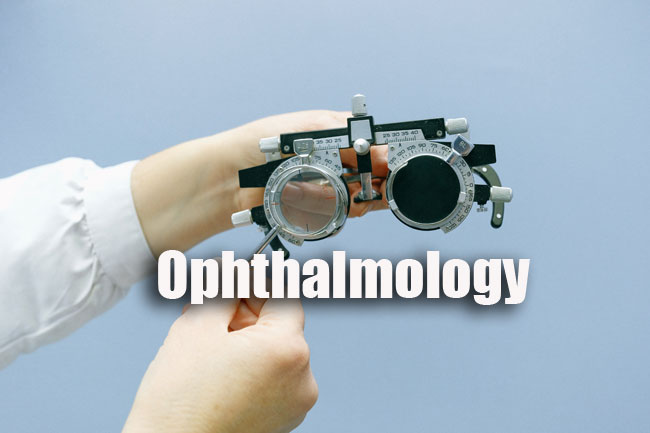Ophthalmology Practice Set
Ophthalmology Practice Set paper for the written examination is given below. Candidates who are looking for Ophthalmology exam Practice Set paper can find in this section. The applied candidates who are getting prepared for the Ophthalmology can view this page for the Ophthalmology Last Ten Years Practice Set Papers.

Download the Ophthalmology Practice Set & Solutions & make it as a reference for your exam preparation. Take advantage of these Ophthalmology Practice Set Papers in a proper manner to get qualifying Marks. Last 5 years Ophthalmology Practice Set Papers provided here. Candidates who are applied for the above exam can check and download the Ophthalmology Practice Set Papers from here.
Practice Set of Ophthalmology
1. The only extraocular muscle which does not arise from the apex of the orbit is —
(1) Superior rectus
(2) Superior oblique
(3) Inferior oblique
(4) Inferior rectus
2. The type of optic atrophy that follows retro — bulbar neuritis is —
(1) Secondary optic atrophy
(2) Consecutive optic atrophy
(3) Glaucomatous optic atrophy
(4) Primary optic atrophy
3. Most common cause of adult unilateral proptosis is —
(1) Thyroid ophthalmopathy
(2) Metastasis
(3) Lymphoma
(4) Meningioma
4. With regard to the anatomy of the lacrimal sac, which statement is correct?
(1) Itis Jateral to the angular vein.
(2) It is only related to the medial palpebral ligament posteriorly.
(3) It lies adjacent to the superior meatus of the nose.
(4) It lies in the lacrimal fossa and lamina papyracea is thinnest bone.
5. Bulging in limbal area lined mostly by iris tissue usually occurs after perforation or untreated glaucoma is. —
(1) Ciliary staphyloma
(2) Equatorial staphyloma
(3) Intercalary staphyloma
(4) Posterior staphyloma
6. Which one of these is an early pathological feature of diabetic retinopathy?
(1) Capillary basement membrane thinning
(2) Increased retinal blood flow
(3) Loss of capillary pericytes
(4) Retinal capillary closure
7. The youngest lens fibres are present in —
(1) Central core of lens nucleus
(2) Outer layer of nucleus
(3) Deeper layer of cortex
(4) Superficial layer of cortex
8. Angle closure glaucoma can be precipitated by —
(1) Phenytoin
(2) Topiramate
(3) Valproate
(4) Carbamazepine
9. Least common corneal dystrophy is —
(1) Macular dystrophy
(2) Lattice type I
(3) Lattice type III
(4) Granular corneal dystrophy
10. Universal marker of limbal epithelial stem cell is —
(1) Elastin AA
(2) Collagen – BZ
(3) Keratin
(4) ABCG-2
11. Pseudogerontoxon is hallmark sign of —
(1) Trachoma
(2) VKC (Vernal Keratoconjunctivitis)
(3) Atopic Keratoconjunctivitis
(4) Giant papillary conjunctivitis
12. Only complication of trachoma is —
(1) Trichiasis
(2) Entropion
(3) Corneal opacity
(4) Corneal ulcer
13. Active and sudden onset of flashes and floaters in 55 age patient is usually —
(1) Posterior vitreous detachment
(2) Vitreous haemorrhage
(3) Retinal vein occlusion
(4) Retinal detachment
14. True regarding cotton wool spots are all, except —
(1) Result from arteriolar occlusion in the nerve fibre layer
(2) Tend to persist for a shorter duration in hypertensive retinopathy as compared to diabetic
(3) Are usually greater than 1 disc diameter in size
(4) Result from interruption of axoplasmic flow
15. All of the following take part in the pathogenesis of macular edema in diabetic retinopathy, except —
(1) Retinal pigment epithelium dysfunction
(2) Oxidative stress
(3) VEGF
(4) Increased protein kinase —C
16. A 7-year-old presents with left exotropia; right eye has 6/6 vision with normal fundus. Left eye has only close hand movements with subretinal yellow exudates and retinal detachment and telengiectatic vessels. Diagnosis is —
(1) Sympathetic ophthalmia
(2) Coats disease
(3) ROP
(4) Familial Exudative Vitreoretinopathy (FEVR)
17. With regard to the sclera, which statement is incorrect?
(1) It consists of regularly spaced collagen fibers.
(2) It fuses posteriorly with the dural sheath of the optic nerve.
(3) It is pierced by the vortex veins posterior to the equator.
(4) It is thinnest behind the insertions of the rectus muscles.
18. The most frequent cataract type seen in adult retinitis pigmentosa patient is —
(1) Posterior subcapsular
(2) Anterior polar
(3) Cortical
(4) Mixed
19. How many mm (distance) from the limbus is the safest site of intravitreal injection?
(1) 1-2mm
(2) 2-3mm
(3) 3-4mm
(4) 4-5 mm
20. The action of inferior oblique is —
(1) Depression, extorsion, abduction
(2) Depression, extorsion, adduction
(3) Elevation, intorsion, abduction
(4) Elevation, extorsion, abduction
| Practice Set | MCQs |
| Quiz | Questions and Answers |
| Ophthalmic Surgery |
21. Horner’s syndrome is characterized by all of the following, except —
(1) Miosis, anhidrosis
(2) Enopthalmos
(3) Ptosis
(4) Presence of cilitospinal reflex
22. Amsler’s grid is used to evaluate —
(1) Central 10 degree of vision
(2) Central 20 degree of vision
(3) Peripheral vision
(4) Lens opacity
23. Newer method to treat open-angle glaucoma is —
(1) Cryopexy
(2) Cyclodiathermy
(3) Argon laser
(4) Cyclo micro-pulse laser
24. The newest technique for IOL power calculation in which ray tracing and instead of A constant, C constant is used, is —
(1) Haigis formula
(2) Olsen formula
(3) Binkhorst — II
(4) Barrett Universal II
25. What is the most important sign of globe rupture due to blunt trauma?
(1) Chemosis and Hyphaene
(2) Prolapse of iris
(3) Hypotony
(4) Sub normal vision
26. Stocker’s line is seen in —
(1) Pinguecula
(2) Trachoma
(3) Pterygium
(4) Concretions
27. Drug which increase uveoscleral outflow –
(1) Epinephrine
(2) Prostaglandins
(3) Apraclonidine
(4) All of the above
28. To assess the corneal biomechanics, the best device is —
(1) Topographer
(2) Ocular response analyzer
(3) Corvis—ST
(4) Tomogram
29. The diagnostic modality of choice to diagnose retinoblastoma in children is —
(1) CT Scan with Contrast
(2) MRI with Contrast
(3) USG—B-Scan
(4) X-ray – Digital
30. A window defect in FFA is usually due to —
(1) Dysfunction of vascular endothelial tight junction
(2) Due to prolonged retention in tissue
(3) Due to breakdown of RPE tight junction
(4) Due to normal choroidal fluorescence through a defect or loss of RPE
31. Reduced blinking frequency in thyroid ophthalmopathy is termed as —
(1) Kocher’s sign
(2) Stellwag’s sign
(3) Griffith’s sign
(4) Von Graefe’s sign
32. Lateral wall of orbit is formed by —
(1) Orbital surface of greater wing of sphenoid and frontal process of zygomatic
(2) Lesser wing of sphenoid and frontal process of zygomatic
(3) Lesser wing of sphenoid and maxillae
(4) Frontal bone and lesser wing of sphenoid
33. Blunt injury to eye causes recession of angle of eye because of —
(1) Tear of ciliary body
(2) Schlemm canal split
(3) Trabecular meshwork split
(4) Dislocation of the lens
34. Vortex keratopathy is common side effect of —
(1) Amiodarone
(2) Latanoprost
(3) Phenothiazine
(4) Pilocarpine 2%
35. Attachment of vitreous is strongest at —
(1) Foveal region
(2) Back of lens
(3) Across ora serrata
(4) Margin of optic disc
36. All are present in Reiter syndrome, except —
(1) Cataract
(2) Conjunctivitis
(3) Uveitis
(4) Retinal vasculitis
37. Deficiency of Vitamin B1 (Thiamine) causes —
(1) Internal ophthalmoplegia
(2) External ophthalmoplegia
(3) Retrobulbar neuritis
(4) Corneal anaesthesia
38. In rheumatoid arthritis, all are present, except —
(1) Glaucoma
(2) Iridocyclitis
(3) Dry Eye
(4) Scleritis
39. In 2006—7 RAAB survey most common cause of blindness after cataract is —
(1) Glaucoma
(2) Refractive error
(3) Corneal opacity
(4) ARMD
40. Accessory lacrimal gland of Wolfring are situated at —
(1) Lower tarsus
(2) Upper tarsus
(3) Bulbar conjunctiva
(4) Limbus
41. Commonest congenital tumor of conjunctiva is —
(1) Pinguecula
(2) Epibulbar dermoid
(3) Nevus of Ota
(4) Trachoma
42. Conjunctival Goblet cells secrete —
(1) Lipid
(2) Mucous
(3) Aqueous
(4) None of the above
43. Cause of Mucin deficiency in dry eye —
(1) Trachoma
(2) Ocular pemphigoid
(3) S—J syndrome
(4) All of the above
44. Conjunctival Epithelium is —
(1) Pseudo stratified
(2) Stratified columnar
(3) Transitional
(4) Stratified non-keratinized squamous
45. Thickest portion of sclera —
(1) Anterior to rectus muscle insertion
(2) Posterior ‘to rectus muscle insertion
(3) Posterior pole
(4) Limbus
46. Yoke muscle for right superior rectus is —
(1) Left superior rectus
(2) Left inferior rectus
(3) Right superior oblique
(4) Left inferior oblique
47. Jn aqueous formation share of ultrafiltration is —
(1) 15%
(2) 25%
(3) 50%
(4) 75%
48. Which part of orbicularis oculi is known as Horner’s muscle?
(1) Lacrimal
(2) Orbital
(3) Temporal
(4) Miuller’s muscle
49. Fincham’s test differentiates cataract from —
(1) Conjunctivitis
(2) Acute congestive glaucoma
(3) Inidocyclitis
(4) Keratitis
50. Hutchinson’s rule is related to —
(1) Herpes simplex keratitis
(2) Herpes zoster keratitis
(3) Mycotic keratitis
(4) Third nerve palsy



